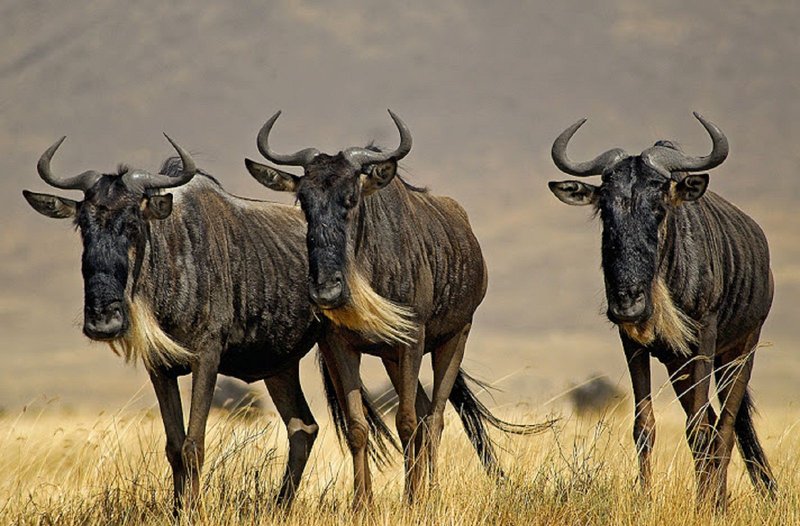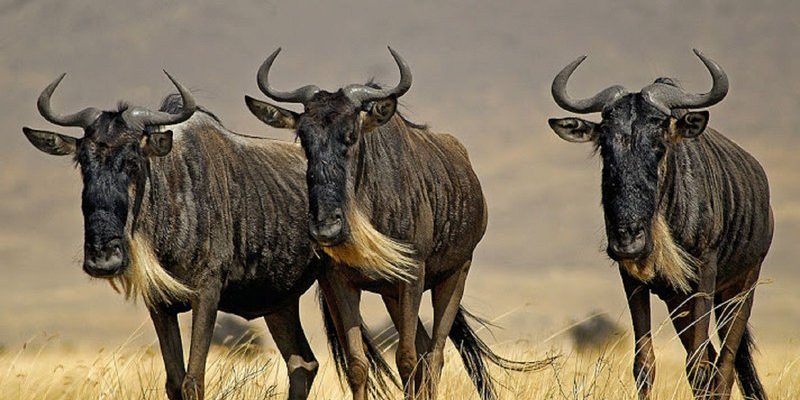
Often, people picture wildebeests as just another herd animal, but there’s so much more to them! Understanding what they’re really about can help us appreciate them not just as a part of the landscape, but as unique animals with interesting behaviors and social structures. Let’s clear up the confusion and learn more about these incredible creatures.
Myth 1: Wildebeests Are Just Cows in Africa
You might be thinking, “Aren’t wildebeests just like cows?” Well, **not quite**. While they are both part of the **bovine family**, wildebeests, or **gnu**, showcase their own unique characteristics and behaviors that set them apart from our farm-fancy friends.
Physical Differences
Wildebeests have a distinctive appearance. They have a large, boxy body with curved horns and a long tufted tail. Cows, on the other hand, generally have a more rounded body and different horn shapes depending on the breed. The wildebeest also has a mane of hair along its neck, which gives it a wild look!
Behavioral Traits
When it comes to social structure, wildebeests are much more nomadic than domestic cows. They migrate in search of food and water, often traveling hundreds of miles in a single year. This behavior is driven not just by survival, but also by the seasonal changes in their habitat. So, while cows may prefer lounging in a pasture, wildebeests thrive on movement and adapt to their environment’s needs.
Myth 2: Wildebeests Are Dull-Witted Animals
You might think that something as common as a wildebeest can’t be too bright, but here’s the thing: **wildebeests are quite clever.** Like most animals in the wild, they’ve developed a range of behaviors to survive in their challenging environments.
Survival Instincts
Wildebeests are known to travel in large herds, which provides safety in numbers. This isn’t just a random decision; it’s a strategic move. Being in a group can confuse predators like lions, making it harder for them to pick out a single animal. Plus, they have a keen sense of smell, which helps them sense danger from afar.
Social Behaviors
Interestingly, wildebeests also exhibit social interactions that might surprise you. They have strong bonds and can communicate through various vocalizations and body language. This social network helps them stay alert to threats, which shows they aren’t just wandering aimlessly.
Myth 3: All Wildebeests Migrate Together
It’s a common misconception that all wildebeests participate in the grand migration. In reality, not every wildebeest takes part. The great migration mainly involves two species: the **blue wildebeest** and the **black wildebeest**, and even within these species, migration patterns can vary.
Migration Specifics
The migration of the blue wildebeest, for example, is what you often see on documentaries—thousands of them crossing rivers in search of greener pastures. However, black wildebeests are more localized and do not join in on these massive treks. They tend to live in smaller groups and stay closer to their home ranges.
Environmental Factors
Weather and food availability can also affect migration patterns. If conditions aren’t right, some wildebeests might stay behind, leading to a mix of migratory and sedentary populations. It’s a great reminder that nature can be a lot more complex than it seems!
Myth 4: Wildebeests Only Migrate for Food
Sure, it’s easy to see the wildebeest migration as a quest for greener grass, but there’s more to it. While food availability is a key factor, **wildebeests also migrate for breeding purposes.**
Breeding Dynamics
During migration, males often establish territories and compete for mates. This ensures that the strongest genes are passed on to the next generation. It’s not just a simple buffet line—they’re also thinking about their legacy in the animal kingdom.
Social Structure
Additionally, being on the move allows wildebeests to maintain their herd dynamics, promoting genetic diversity. This is essential for the health of their populations. So, the next time you see a herd on the move, remember that they’re not just looking for food; they’re ensuring the survival of their species too!
Myth 5: Wildebeests Are Easy Prey
It’s true that wildebeests are on the menu for many predators, but calling them “easy prey” doesn’t tell the whole story. In fact, they have several strategies to evade capture.
Defense Mechanisms
One of their strongest defenses is their **group behavior.** When threatened, the herd will often panic and scatter, confusing predators. This natural instinct to herd together provides a significant advantage in numbers. Additionally, they can run quite fast, reaching speeds of up to 50 miles per hour, which helps them escape danger.
Strength in Numbers
When under attack, wildebeests often band together, which can deter predators like lions. They may prioritize defending their young by forming a protective circle around calves during a predation attempt. This kind of teamwork is essential in the wild for survival.
Wildebeests are much more than just “African cows” or “easy prey.” They’re fascinating creatures filled with unique behaviors and social structures. Understanding these incredible animals can deepen our appreciation of them and the ecosystems they inhabit.
By breaking down myths, we can acknowledge the importance of conserving their habitats and respecting their place in the circle of life. So, whether you’re watching them from a safari vehicle or learning about them from your couch, keep in mind that these beasts have a story to tell—one filled with cleverness, strength, and resilience.

